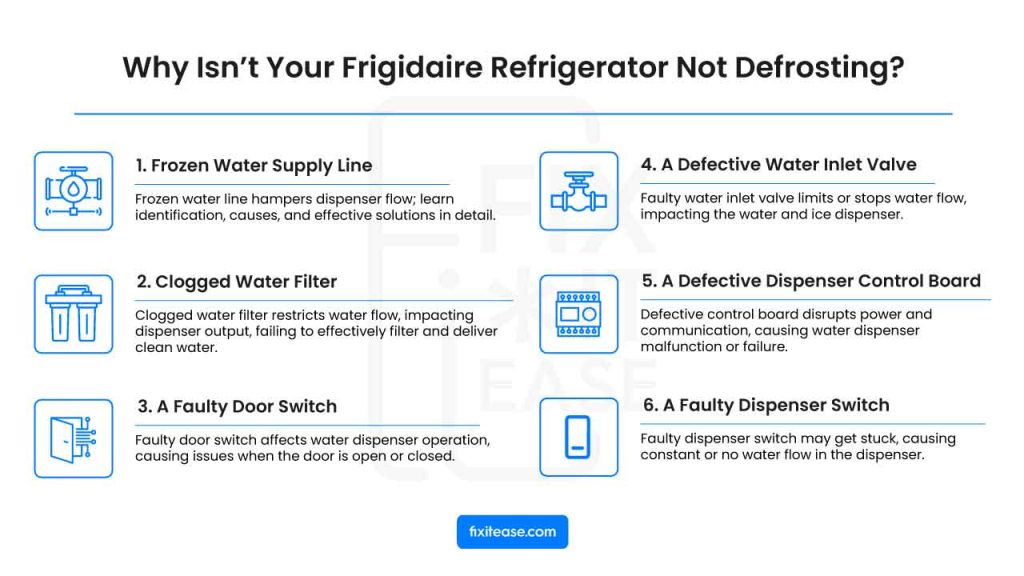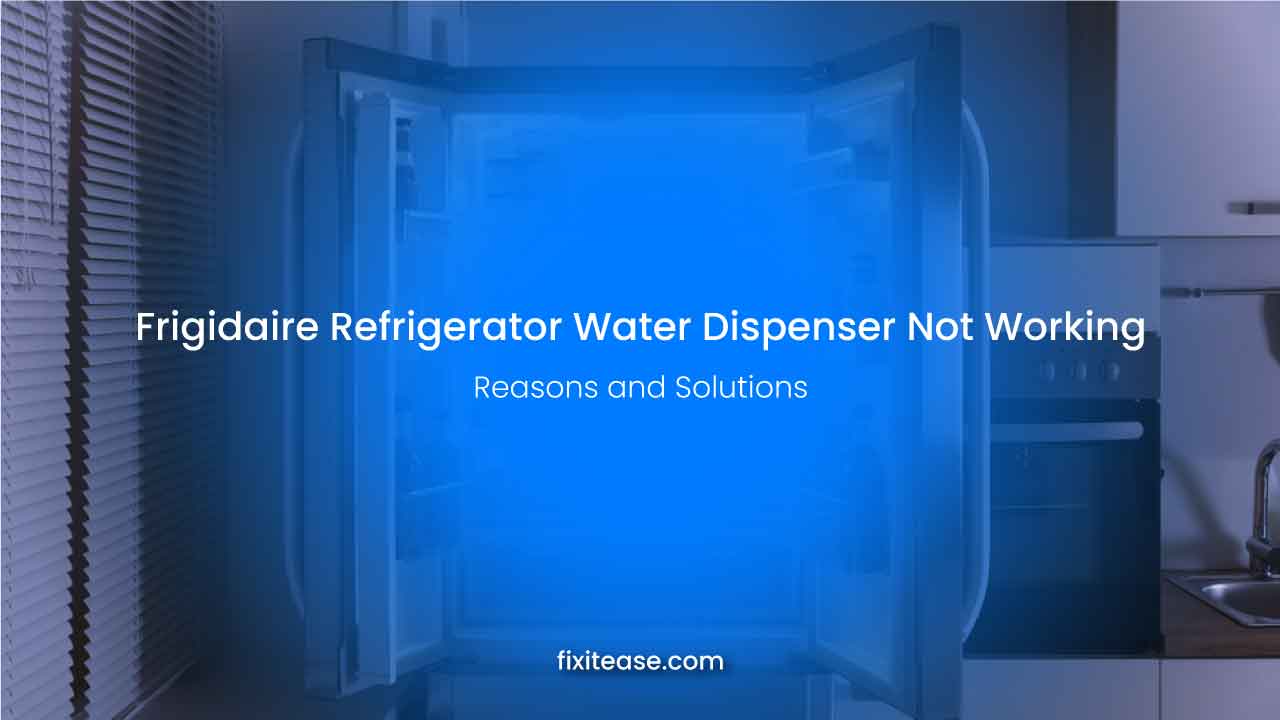Frigidaire Refrigerator Water Dispenser Not Working – Reasons and Solutions
Fridgfire refrigerators have some common issues including the water dispenser issue. When it doesn’t dispense the water, or provide water at the wrong temperature, it impacts the appliance’s usability and performance. But why is your Frigidaire refrigerator water dispenser not working and what should be your action towards it?
There could be a frozen water line, a clogged water filter, a faulty door switch, a defective water inlet valve, a defective dispenser control board, or a faulty dispenser switch that can cause your refrigerator’s water dispenser to work improperly.
Let’s scroll down to learn more about the issue and the possible solutions. In this article, you’ll get exactly what you’re looking for.
Why Is Your Frigidaire Refrigerator Water Dispenser Not Working?

The reasons can be many. Let’s get to know about them in detail.
1. Frozen Water Supply Line
When the water supply line to the refrigerator’s dispenser becomes frozen, it hinders the flow of water. In this section, we’ll explore how to identify this problem, what causes it, and how to effectively fix it.
What Causes It
- Freezer Temperature Setting: If the freezer’s temperature is set too low, it can cause the water line to freeze. The recommended temperature for the freezer is between 0-10 degrees Fahrenheit.
How to Identify
- Disconnect and Test: Start by disconnecting the water tube at the bottom of the refrigerator’s door. Try to blow air through the tube. If air cannot pass through, it’s likely that the water line is blocked with ice.
How to Fix It
- Adjust Freezer Temperature: Increase the freezer’s temperature to the manufacturer’s recommended setting, typically between 0-10 degrees Fahrenheit. Give it a few hours for any ice in the line to thaw.
Other considerations:
- Water Line is Kinked: Check for kinks in the water line. Straighten any kinks to restore water flow.
- Low Water Pressure: The water inlet valve requires sufficient water pressure to function correctly. If the pressure is too low, the valve may not open. If pressure measures less than 20psi, consider increasing your home’s water pressure to ensure proper valve operation.
2. Clogged Water Filter
A water filter in a refrigerator purifies the water that enters your home through the municipal water supply, removing contaminants and impurities. When a water filter becomes clogged, it restricts the flow of water, leading to reduced or no water output from the dispenser, as it can’t effectively filter and deliver clean water.
What Causes It
- Expiration: Water filters have a specific lifespan and typically need replacement every six months. Depending on your refrigerator model, the manufacturer might recommend this replacement schedule.
- Contaminants and Sediment: Clogs can occur due to the accumulation of sediment and contaminants, especially if you live in an area with hard water or if your municipal water supply isn’t adequately treated.
- Improper Installation: Incorrect installation can also lead to clogs, which may happen if you don’t follow the manufacturer’s instructions accurately or attempt to install the filter without professional assistance.
How to Identify
- Check the Water Filter Location: Locate the water filter in the back, right corner of your refrigerator. It filters the water that enters your home from the municipal water supply.
- Assess for Reduced Water Flow: If your water dispenser is working slowly, or not at all, it’s a possible sign of a clogged water filter. Additionally, if your ice maker produces smaller or no ice cubes, this could be linked to the same issue.
How to Fix It
- Replace the Water Filter: If your water filter has reached its recommended lifespan, consult the manufacturer’s instructions for proper replacement. If you’re uncertain about this process, it’s advisable to seek assistance from a professional appliance repair person.
- Flushing the Filter: In cases of clogging without expiration, make sure you clear the filter by flushing it with clean water. Remove the filter from the refrigerator and run it under running water for a few minutes. If this doesn’t resolve the issue, consider purchasing a new filter.
- Ensure Correct Installation: Verify that the water filter is installed correctly by following the manufacturer’s instructions or consulting a professional appliance repair person. Avoid attempting installation on your own unless you are confident in your abilities.
3. A Faulty Door Switch
A door switch in a refrigerator is responsible for deactivating the water and ice dispenser when the refrigerator door is open to prevent leaks. If the door switch becomes faulty, it may not properly activate or deactivate the dispenser, causing it to not work when the door is open or closed, leading to a non-functioning water dispenser.
What Causes It
- Improper Usage: If the ice maker switch is accidentally left on when the refrigerator door is open, this can lead to the water dispenser being turned off.
- Temperature Changes: Extended periods of the refrigerator door being left open, causing the internal temperature to rise significantly, can also result in the door switch deactivating the water dispenser.
How to Identify
- Location: The door switch is typically positioned near the top of the fridge, close to the door hinges.
- Dispenser Inactivity: When you open the fridge door and notice that the water and ice dispenser does not operate, it’s an indicator that the door switch may be malfunctioning.
- Ice Maker Switch: Ensure that the ice maker switch is turned off when the refrigerator door is open. If the switch is turned on, it can deactivate the water dispenser.
How to Fix It
- Ice Maker Switch: First, ensure that the ice maker switch is turned off when the refrigerator door is open.
- Cool Down: If the door switch is triggered due to high internal temperature, close the refrigerator door and wait for the temperature inside to cool down. This should reactivate the water dispenser.
- Replacement: If the above steps do not resolve the issue, the door switch may need replacement. To replace it, locate the door switch, usually near the top of the fridge, close to the hinges. Then, disconnect the power supply to the fridge by either unplugging it from the wall or switching off the circuit breaker.
Remove the screws holding the switch in place. Carefully detach the switch, noting its wiring configuration. Install the new switch in the same position and secure it with screws. Finally, reconnect the power supply to the fridge and test the new switch by opening and closing the door. The water dispenser should activate and deactivate as the door is opened and closed.
4. A Defective Water Inlet Valve
A water inlet valve in a refrigerator controls the flow of water into the appliance. It opens and closes to supply water to the water and ice dispenser when activated. If the water inlet valve is faulty, it may not open properly, leading to restricted or no water flow, causing the water dispenser to malfunction or not work at all.
What Causes It
- Low Water Pressure: If the water pressure from your home’s supply is below the required 20 psi, the valve may not open and close properly, resulting in water flow issues.
- Electrical Malfunctions: Defects in the valve’s electrical components can lead to an inability to open or close effectively.
How to Identify
- Malfunctioning Operation: If the water inlet valve is defective, it may not respond as expected when you press the dispenser button or lever. This can result in issues like water not flowing when it should or leakage.
- Low Water Pressure: If there isn’t enough water pressure (at least 20 psi), the valve may fail to function correctly.
How to Fix It
- Check Water Pressure: Ensure that the water pressure from your home’s supply is at least 20 psi. If it’s below this threshold, you may need to address water pressure issues within your plumbing.
- Inspect for Damage: Unplug the refrigerator and turn off the water supply. Examine the water inlet valve and connected lines for any signs of leaks or damage.
- Test Electrical Continuity: If you have electrical skills, you can use a multimeter to test the solenoid coils of the valve for continuity. Disconnect the two wires from the coil terminals and use the multimeter to check for a steady electrical supply. If the solenoid is not receiving a steady current, it may need replacement.
- Replace the Valve: If the water inlet valve is confirmed as defective, it will need to be replaced. To replace it in the right way, turn off the water supply to the refrigerator first.
Then, disconnect the water line from the valve and remove the screws securing the valve in place. Carefully pull out the old valve and insert the new one. Reconnect the water line to the new valve. Turn on the water supply and test the new valve by dispensing water from the fridge.
5. A Defective Dispenser Control Board
A control board in a refrigerator serves as the central control unit for various functions, including the water dispenser. It regulates the flow of power and signals to components like the water dispenser.
When the control board is defective, it can disrupt the communication and power supply to the dispenser, causing it to malfunction or not work at all.
What Causes It
- Short Circuit: The control board may short-circuit due to exposure to moisture or wiring problems.
- Power Supply Issues: It can also fail to provide power to the water dispenser, which may be caused by a problem with the fuse or the power supply itself.
- Communication Failure: In some cases, the dispenser control board may fail to send a signal to the water dispenser, often due to wiring or control board issues.
How to Identify
- Location: The dispenser control board is typically located behind the water dispenser.
- Testing with a Multimeter: To determine if it’s faulty, unplug the refrigerator and remove the dispenser control board. You can then test it with a multimeter to check if it is receiving power. If it’s not, the control board may be the issue.
How to Fix It
- Locate the Control Board: The control board is typically situated behind the water dispenser.
- Disconnect Power: Prior to any work, ensure the refrigerator is unplugged or that the circuit breaker is switched off.
- Remove the Old Control Board: Carefully remove the screws that hold the old control board in place. Gently pull out the old control board.
- Install the New Control Board: Insert the new control board, making sure to line up the holes correctly before securing it in place with screws.
- Reconnect Power: Once the new control board is in position, reconnect the power to the refrigerator.
- Test the Water Dispenser: After all steps are completed, test the water dispenser to ensure it functions correctly with the new control board in place.
6. A Faulty Dispenser Switch
A dispenser switch in a refrigerator controls the water dispenser. When you press the water dispenser lever, the switch activates, sending power to the water inlet valve, allowing water to flow.
If the dispenser switch is faulty, it can get stuck in the “on” or “off” position, preventing proper activation. It can lead to constant water flow or no water dispensing, causing the water dispenser not to work correctly.
What Causes It
- Stuck in the “On” Position: When the switch is stuck in the “on” position, water will continuously flow from the dispenser, even when you don’t intend it to.
- Stuck in the “Off” Position: Conversely, if the switch is stuck in the “off” position, no water will come out of the dispenser, regardless of how often you press the lever.
How to Identify
- Locate the dispenser switch in your refrigerator. Please consult your refrigerator’s manual to find its exact location, as it can vary based on the model.
- Test the dispenser switch using a multimeter to determine if it’s functioning correctly. This step will help confirm if the switch is the source of the problem.
How to Fix It
If the dispenser switch is stuck in the “on” position, you should replace it. If it’s stuck in the “off” position, you can try cleaning it with a cotton swab soaked in rubbing alcohol. If cleaning doesn’t work, you’ll still likely need to replace it.
To replace the dispenser switch, follow these steps:
- Remove the front panel of your fridge to access the switch. Refer to your refrigerator’s manual for specific instructions.
- Carefully disconnect the old switch. Install the new switch by following the manual’s instructions and securing it properly.
FAQs
Why is no water coming out of my water dispenser?
If no water is coming out of your water dispenser, it could be due to several issues. Firstly, check if the water supply is connected and the valve is open. Secondly, ensure that the dispenser switch is working correctly. If the switch is stuck in the “off” position, no water will flow.
Additionally, clogged water filters, frozen water lines, or a malfunctioning water inlet valve can also lead to this problem. Carefully investigate these factors to identify and resolve the issue.
Why is my Frigidaire not dispensing water after changing filter?
The reasons can be many. First, ensure the filter is installed correctly and fully seated. Sometimes, air bubbles in the new filter can temporarily block water flow, so run a few gallons of water to clear them. Also, check if the dispenser switch is functioning properly, and inspect the water lines for any kinks or obstructions.
If the issue persists, it might be a faulty filter or a problem with the water inlet valve, which may require professional attention.
Is water dispenser repairable?
Yes, water dispenser issues in refrigerators are often repairable. Problems like a faulty dispenser switch, clogged water lines, or a malfunctioning water inlet valve can usually be fixed.
Some repairs can be DIY, like changing the filter or cleaning components. However, more complex issues might require professional help. In rare cases, if a critical component is severely damaged, it may be more cost-effective to replace the entire dispenser unit. The repairability depends on the specific problem and your skill level.
Last Thoughts
In summary, when your Frigidaire refrigerator’s water dispenser isn’t working, there are a few common culprits to consider. It could be a faulty dispenser switch, improper filter installation, or clogged water lines. The good news is that most of these issues can be resolved. Proper diagnosis, maintenance, and, if necessary, professional help are the keys to getting your water dispenser back to its refreshing best.
Remember to consult your refrigerator’s manual for specific instructions and take simple steps to ensure your dispenser is functioning as it should.


![8 Common GE Refrigerator Problems [With Expert Solutions]](https://fixitease.com/wp-content/uploads/2023/11/Common-GE-Refrigerator-Problems-768x432.jpg)

